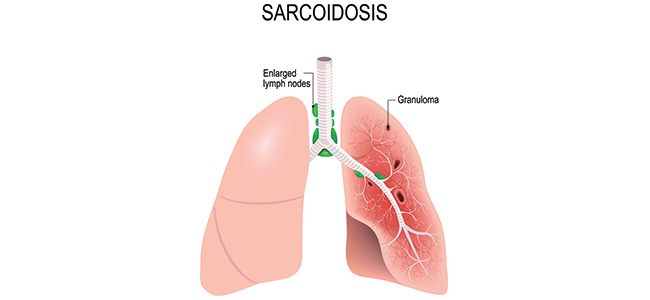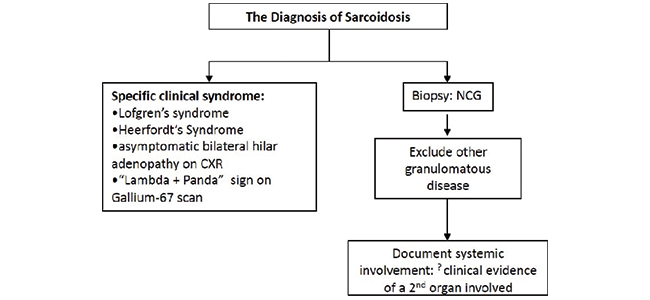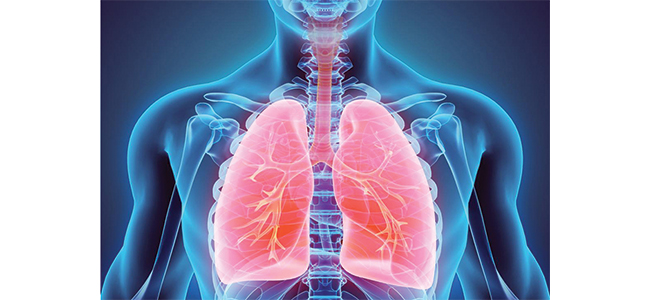Sarcoidosis
Home » Sarcoidosis

Sarcoidosis is a disease in which inflammation produces tiny lumps of cells in organs throughout the body. The lumps, called granulomas, most often appear in the lungs, but they also can occur in the lymph nodes, eyes, skin or other areas of the body.

The cause of sarcoidosis is unknown. The disease can affect people of every race, sex and age. Sarcoidosis is more common in African-Americans, and those of German, Irish, Scandinavian, Asian and Puerto Rican origin. It appears most often in young people between 20 and 40 years of age. It is not contagious.

Many people with sarcoidosis do not have any symptoms. Others have only vague symptoms that can be seen in many other illnesses, such as weight loss, fever, loss of appetite, depression, night sweats, and sleep problems. Symptoms that may come from problems with a specific organ include:
•Lungs: Shortness of breath, wheezing or dry cough that may disappear over time.
•Eyes: Burning, itching, tearing, redness, sensitivity to light, dryness, seeing black spots, blurred vision, reduced color vision, and, in rare cases, blindness.
•Skin: Bumps, ulcers, or rarely, flat areas of discolored skin that appear mostly near the nose or eyes or on the back, arms, legs and scalp. Painful and tender bumps can also appear on the ankles and shins.
•Bones and Joints: Bone lumps (nodules), causing pain in the hands and feet and sometimes pain and swelling in the ankles or other joints
•Heart: Shortness of breath, swelling in the legs, wheezing, coughing, and chest pain. One may have a feeling of an irregular or fast heart beat at times, or even pass out without warning.
•Salivary Glands: Swelling (which may make the cheeks look puffy) and an overly dry mouth and throat.

There is no one diagnostic test to diagnose sarcoidosis. The doctor is likely to perform a variety of tests, which may include:
•Medical history and physical exam to look for signs of sarcoidosis and rule out other diseases.
•A chest X-ray and CT scan to look for enlarged lymph nodes and small round spots in the lungs
•Pulmonary function tests to give an indication of how well the lungs work
•A tissue biopsy—taking a small piece of tissue to examine under a microscope to look for signs of disease. In the lung, this is usually done through the airways using a proceedure called bronchoscopy.
•Blood tests such as ACE, liver and kidney function tests
•Eye examination

The course of sarcoidosis varies greatly among people.
•In many cases, sarcoidosis is mild. It makes a brief appearance, and then the granulomas may stop growing or shrink. Symptoms may go away within a few years without treatment.
•In the moderate form of sarcoidosis, inflammation remains but does not worsen. People with moderate sarcoidosis may have symptoms or flare-ups and only need treatment at times.
•The severe form of sarcoidosis slowly worsens over a period of years, and can cause permanent organ damage. Treatment can help, but the disease may still leave scar tissue in the lungs, skin, eyes or other organs. Between 20 and 30 percent of people with pulmonary sarcoidosis end up with permanent lung damage. For some patients, sarcoidosis can become chronic, lasting for many years.

For some sarcoidosis patients, their condition will improve without any treatment. Those who do need treatment are given medicine to reduce inflammation and slow the growth of the granulomas. Treatment is aimed at maintaining good lung function, reducing symptoms and preventing organ damage. Medications for sarcoidosis include: Corticosteroids. The most common corticosteroid prescribed for sarcoidosis is prednisone. Other newer drugs include methotrexate and infliximab.

Many people with sarcoidosis can lead normal lives, and are able to carry on with their usual activities.

